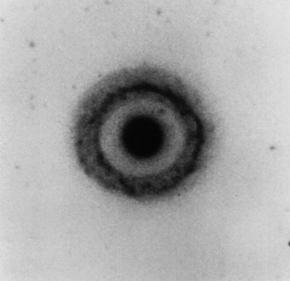
|



17.2. The One-armed Outer Ringed Galaxy NGC 4378
Another possible example of a tidally-generated ring in a nonbarred galaxy is provided by NGC 4378, a low-inclination spiral in the direction of the Virgo Cluster. In blue-light images in Sandage (1961), Rubin et al. (1978), and SB94, the spiral structure appears to be distinctly one-armed, and in the outer regions, this single arm appears to nearly close into an outer ring, hence the revised classification is (R)SA(s)a in RC3. Since the vast majority of outer pseudorings are defined by two spiral arms, the origin of this interesting structure was investigated by Byrd et al. (1994), who deduced from numerical simulations that, unlike the probable leading single arm in NGC 4622, the arm in NGC 4378 could be an impulsive trailing arm created by the grazing passage of a small companion. The actual trailing nature of the arm was recently confirmed by Byrd et al. (1996), who used optical broad-band images in conjunction with published kinematic data to deduce the near side of the galaxy's disk (following a technique described by de Vaucouleurs 1958). These broadband images also revealed asymmetry at very low light levels, suggesting that an interaction has indeed affected this galaxy. The Byrd, Freeman, and Howard simulations do not, however, explain why the single arm of NGC 4378 closes into an outer ring.
17.3. Accretion Rings
It is now well-established that some ring features seen in galaxies may represent the result of the accretion of a gas-rich companion or tidal capture of material from a neighboring galaxy (Schweizer et al. 1983). Many galaxies of the polar-ring variety belong to this class (see atlas in Whitmore et al. 1990), and we have already pointed out probable accreted HI rings in section 9.7. An especially interesting optical ring case is Hoag's Object (Hoag 1950), which at first sight looks like a nonbarred ringed galaxy. Photographs by Schweizer et al. (1987b; see Figure 88) reveal an intricate structure in the bright ring, whose projected shape is nearly circular. The classification of the ring as ``inner'' or ``outer'' is unclear, but from its large diameter (about 31 kpc if H0 = 75), it would be in the realm of outer rings. Brosh (1985) suggested that Hoag's object is indeed a ``ringed galaxy'', and that the ring formed when a bar was present, but the bar is now dissolved. Schweizer et al. (1987b) showed, however, that the inner core is an E0 galaxy, not a disk, and suggested the alternative interpretation that the ring resulted from an accretion event 2-3 Gyr ago. Schweizer et al. also used Hoag's Object to define a class called Hoag-type galaxies, which are neither obviously barred nor obviously inclined disks, and which have outer rings including a significant fraction of the total luminosity. They presented a list of seven additional possible candidates from a survey of about 70 objects, and estimated a frequency of 0.1%, indicating that the Hoag class is quite rare.

|
Wakamatsu (1990) observed one of these other candidates, NGC 6028, and detected an oval structure in the central regions reminiscent of a bar. In fact, Wakamatsu examined the other galaxies in the Schweizer et al. list and determined that the only one lacking some elongation in the center was Hoag's Object. In NGC 7742, another galaxy which bears a strong resemblance to Hoag's Object, Wakamatsu et al. (1996) also detected an oval central structure on a high resolution HST image. Wakamatsu suggested that the bar hypothesis is still viable for Hoag's Object because the galaxy lacks any evidence for tidal debris at low light levels. Thus, some of the rings in apparently ``Hoag type'' galaxies could still be resonance rings of the type we have been concerned with. Nevertheless, the possibility that nonbarred ringed galaxies may include both internally and externally-generated rings can certainly explain some of the larger dispersion in properties found for such rings compared to barred galaxies.